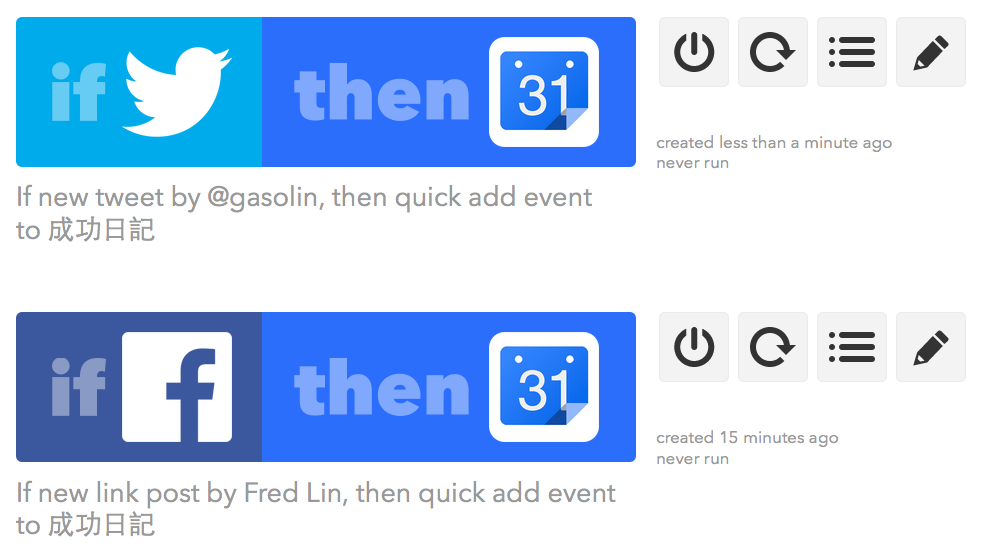為什麼要做個人自動化紀錄?
有人會問,Facebook/Twitter 不就可以記錄大小事了嗎?如果會這麼回答,那就實在太天真了😏 。FB 上也許包含了自己覺得值得分享的事,但生活中還有諸多事情值得記錄,而不適合與大眾分享。 擁有自己的一份完整數位化生活記錄,是我今年的個人目標之一。要達成這個目標,需要藉助一些自動化紀錄工具,好讓整個過程變得自然而不困難。
照片自動化備份 📷
- 360CAM 所拍的相片一律備份到手機
- Dropbox, 自動從手機上傳照片
- Google 相簿,自動從手機上傳照片
- NAS (Synnalogy), 從 Dropbox 同步照片。由於 Dropbox 空間有限,會不定期將 Dropbox 上的照片手動整理備份到 NAS 上.
照片備份規則
我的照片並不算多,但若有出遊的月份通常照片會暴增。所以我的基本備份規則是依年份,並以雙月份命名資料夾,若是當月有重大活動則直接在檔名中標注。
例如 2016 年的照片資料夾裡會有2016_1011,或是2016_06倫敦這樣的命名。
在整理照片的時候,每當遇到特別喜歡的,我會另存到 Dropbox 中的一個依年份歸檔的資料夾,例如 2017 年的精彩照片我會另存到 dropbox/spot/2017資料夾中,這樣隨時可以找出來欣賞。
運動自動化紀錄 🚶♂️
- 記步,睡眠紀錄:小米手環 2
- 體重:小米體重計
今年將每天預定的步數由 3000 步提高到4000步,略高於平常的活動數字,
每天要達成這個目標的話,需要特意地多走幾步路。
update (9/1): 後來不再帶小米手環 2,覺得記錄睡眠與步數意義不大。同時為了降低多走路所需要的意志力,把每日步數改成更容易達成的 300 步,只要開始走,通常都會超過需要的步數。
生活事件自動化紀錄
延續用 IFTTT 做自動生活紀錄這篇的思路,我把看過的書籍、電影,喜歡的 Youtube 影片,貼過的文章,每日完成的事項都記錄到 Google Calendar 中,以方便之後回顧。
自動閱讀 / 觀看紀錄 📚
對於書籍與電影,我使用 RSS + IFTTT + Google Calendar 來自動紀錄。 當我在 Anobii 或豆瓣上修改狀態,Anobii 或豆瓣的 RSS 也跟著改變,這時 IFTTT 會將 RSS 中的新事項紀錄到 Google Calendar 上。 對於 Youtube 上 like 的影片,Facebook 或 Twitter 上新貼的文章,也會透過 IFTTT 紀錄到 Google Calendar 上。
透過 RSS 轉 IFTTT 紀錄
直接透過 IFTTT 紀錄
自動紀錄每日完成的事項 📓
這部份是自動紀錄的核心。使用 Todoist + IFTTT + Google Calendar 即可達成。 我在 Google Calendar 上使用一個單獨的日曆 (成功日記) 來紀錄每日完成的事項。
If task completed in Todoist, Then log into Google Calendar
從 Email 新增待辦事項 ✉️
為了更方便地蒐集待辦事項,我參考這份影片 https://youtu.be/V7Dk7pzjJmM?t=11m30s 來將 Todoist#Inbox 設定為 Email 聯絡人,這樣處理 Email 的過程中也能快速地新增待辦事項。
紀錄看過或待看的網頁 🌐
因為我唯一的收件夾是 Todoist,所以若看到值得閱讀 (紀錄) 的網頁,桌面上我使用自己開發的瀏覽器 Web Extension,搭配 IFTTT 去紀錄網頁到 Todoist,或加個短評分享到 Facebook 或 Twitter。 在手機上就直接使用 Todoist 和 Facebook 等 App 達到一樣的效果。
If new task then create new Todoist item, If share then share to Facebook and Twitter.
文章更新時自動提醒 ⏰
除了偶而瀏覽 Facebook 或 Twitter 上充滿同溫層的快餐短文,我也使用 Feedly 訂閱一些自己挑選過的網站。 然而有些網站並未提供 RSS 訂閱,手機上我會使用Web Alert來取得網頁更新提醒。 搭配 Todoist 稍候閱讀列表,我可以不在看到文章連結當下急著消費,而是在有空閒的時候才閱讀這些文章。
半自動工作紀錄 💼
透過翻看 Todoist 或 Google Calendar,我可以輕易地將過去一週達成的事項整理出來,再送 PR 到 Github 上。 也可以說這塊目前只能算半自動化地列出過去事項列表,可以再繼續改進。
自動化網站部署 🌐
目前已使用 Github 來放我的個人網站與部落格,透過與 Travis CI 整合,我所修改的任何內容,在幾分鐘之內都會自動部署到網站上。
如何做可參考 Hello Hexo (個人網站自動化部署) 和 Automatically deploy new commit to github pages via Travis CI
Auto website deploy flow
一些可以直接運作在瀏覽器的專案 (如 BlocklyDuino 和 Saihubot),我會直接將 gh-pages 設為預設分支,所有改動直接 push 到這分支中。 這樣一有改動即可在網頁上看到更新成果。

